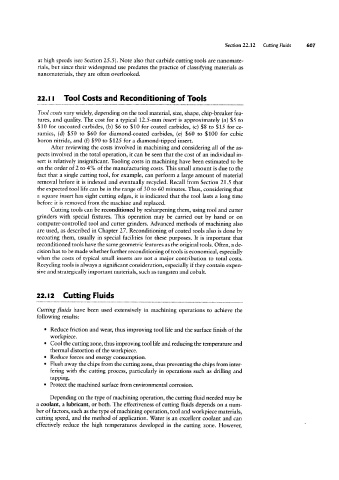Page 626 - 04. Subyek Engineering Materials - Manufacturing, Engineering and Technology SI 6th Edition - Serope Kalpakjian, Stephen Schmid (2009)
P. 626
Section 22 12 Cuttlng Fluids 0
at high speeds (see Section 25 .5). Note also that carbide cutting tools are nanomate-
rials, but since their widespread use predates the practice of classifying materials as
nanomaterials, they are often overlooked.
Tool Costs and Reconditioning of Tools
22.l I
Tool costs vary widely, depending on the tool material, size, shape, chip-breaker fea-
tures, and quality. The cost for a typical 12.5-mm insert is approximately (a) $5 to
$10 for uncoated carbides, (b) $6 to $10 for coated carbides, (c) $8 to $15 for ce-
ramics, (d) $50 to $60 for diamond-coated carbides, (e) $60 to $100 for cubic
boron nitride, and (f) $90 to $125 for a diamond-tipped insert.
After reviewing the costs involved in machining and considering all of the as-
pects involved in the total operation, it can be seen that the cost of an individual in-
sert is relatively insignificant. Tooling costs in machining have been estimated to be
on the order of 2 to 4% of the manufacturing costs. This small amount is due to the
fact that a single cutting tool, for example, can perform a large amount of material
removal before it is indexed and eventually recycled. Recall from Section 21.5 that
the expected tool life can be in the range of 30 to 60 minutes. Thus, considering that
a square insert has eight cutting edges, it is indicated that the tool lasts a long time
before it is removed from the machine and replaced.
Cutting tools can be reconditioned by resharpening them, using tool and cutter
grinders with special fixtures. This operation may be carried out by hand or on
computer-controlled tool and cutter grinders. Advanced methods of machining also
are used, as described in Chapter 27. Reconditioning of coated tools also is done by
recoating them, usually in special facilities for these purposes. It is important that
reconditioned tools have the same geometric features as the original tools. Often, a de-
cision has to be made whether further reconditioning of tools is economical, especially
when the costs of typical small inserts are not a major contribution to total costs.
Recycling tools is always a significant consideration, especially if they contain expen-
sive and strategically important materials, such as tungsten and cobalt.
22.l2 Cutting Fluids
Cutting fluids have been used extensively in machining operations to achieve the
following results:
° Reduce friction and wear, thus improving tool life and the surface finish of the
workpiece.
° Cool the cutting zone, thus improving tool life and reducing the temperature and
thermal distortion of the workpiece.
° Reduce forces and energy consumption.
° Flush away the chips from the cutting zone, thus preventing the chips from inter-
fering with the cutting process, particularly in operations such as drilling and
tapping.
° Protect the machined surface from environmental corrosion.
Depending on the type of machining operation, the cutting fluid needed may be
a coolant, a lubricant, or both. The effectiveness of cutting fluids depends on a num-
ber of factors, such as the type of machining operation, tool and workpiece materials,
cutting speed, and the method of application. Water is an excellent coolant and can
effectively reduce the high temperatures developed in the cutting zone. However,

